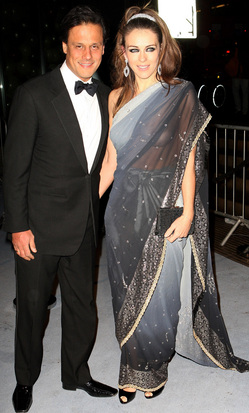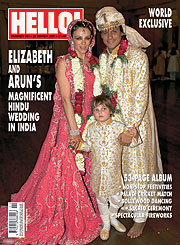 I remember attending a sort of “Hindu pride” class as a
I remember attending a sort of “Hindu pride” class as a pre-teen tween, and being taught the glories of all things Indian (or “Vedic” as our teacher would say). “Vedic clothes” — dhoti for the males and sari for the females — “are simple, clean, modest, and chaste,” our teacher told us about our dress-codes.
Modest? Chaste? Was he kidding? He obviously wasn’t contemplating the mysterious female form draped in that slinky, satiny cloth the same way I was. Moreover, he seemed to have missed the fact that the sari produced the holy grail for hormone-raging 12-year-old boys: the exposed midriff.
I distinctly remember a few Diwali evenings spent sneaking furtive and lusty glances over at the teenage girls decked out in their navel-showing finest.
I also remember feigning disinterest in Bollywood dance numbers with heroines gyrating in rain-soaked saris, only to go back and rewind the video cassettes to ogle those very dance sequences when my parents weren’t home. Particularly memorable (and scandalous) were Mandakaini’s infamous white sari waterfall scene in Ram Teri Ganga Mali, Raveena Tandon’s rainy day in Mohra, and Sridevi’s sari-clad dalliance with an invisible man in Mr. India.
(Okay, okay… fine. Check out the whole collection, here in CNN Go’s round-up of “Sexy Sari Moments.” See, it wasn’t just me.)
Since then, I’ve come to realize that the sari could be scandalous or pious, sexy or sophisticated, chaste or to-be-chased, based on who’s wearing it, and how.
Case in point: Elizabeth Hurley’s recent wardrobe malfunction involving a sheer sari and nothing on underneath.
 Reports the Wall Street Journal:
Reports the Wall Street Journal:
… nothing showed more of Hurley’s cross-cultural fashion sense-or
more of the actress herself-than the sari in which she showed up to the
Love Ball fundraiser in London on Wednesday night. Donning a very sheer
and see-through black outfit, Hurley did not think it necessary to wear
a choli, or cropped blouse, which is customarily worn under the sari.
She also didn’t wear a bra, so photographs of Hurley from that night
leave very little to the imagination. The outfit is sparking serious
sartorial questions: is Hurley a global style pioneer or an
international fashion bandit?
Cross-cultural fashion sense? More like nonsense. I’m going to have to call this as I see it: a
cheap, tasteless publicity stunt. She knew exactly what she was doing: turning nine meters of cloth into a way of grabbing headlines.
 For starters, Liz is no novice to the sari. The fellow on her arm is her husband, Indian textile heir Arun Nayar. The two were wed in a Hindu ceremony in 2007, where the blushing bride proudly (and beautifully) wore a sari. And she
For starters, Liz is no novice to the sari. The fellow on her arm is her husband, Indian textile heir Arun Nayar. The two were wed in a Hindu ceremony in 2007, where the blushing bride proudly (and beautifully) wore a sari. And she
was famously photographed in a sari with Gwyneth Paltrow and Elton John for the
Breast Cancer Research Foundation’s “Hottest Pink Party Ever” in 2008.
Liz knows how a sari is worn. And if she had any doubt, she could have asked hubby Arun. “Sweetie, am I forgetting something, here? Could you give me your expert opinion on this… you know, especially since you are Indian, and run a textile company and all.”
To be fair, it is possible that the nature of the sari’s fabric made it look one way at home, and another under the glare of a paparazzi’s flashbulb. But as a celebrity used to attending showbiz parties, shouldn’t she have been aware of the revealing glare of the camera flash?
And the question still remains: why in the world would she not where anything — not the traditional choli blouse, not even a bra — under a light wrap of cloth?
Of course, some of the media have rushed to Hurley’s aid to answer this rather simple question with an unexpected answer: Liz is just keeping it real, bringing the sari back to its (supposed) roots. Here’s the WSJ again:
But even sans choli, Hurley has gotten support from many Indian
designers and journalists for her fashion selections. The Daily Mail in
Mumbai says: “By contemporary Indian standards, [wearing a sari without
a choli] is unthinkable. But it would seem, at the very least, Hurley
has history on her side.” The Daily Mail goes on to say that the choli
was non-existent in India before the British arrived. In fact, it was
Victorian ideas of modesty that led to its invention.
Um, right. Even if one accepts the (highly debatable) idea that the choli was a British import and that Indian women traditionally went commndo, are we seriously to believe that Liz has been boning up on her pre-colonial Indian history? And that she intentionally renounced her choli to kick off some retro-Vedic equivalent of the bra burning movement? Really?
I think Liz ought to say sa– er, sorry, and let us all move on. I, for one, am getting pretty tired of focusing this much energy on the image of a sari-clad choli-less attention-seeking celebrity.
Of course, I’ll be the first to admit that I probably would’ve felt quite differently when I was 12.

